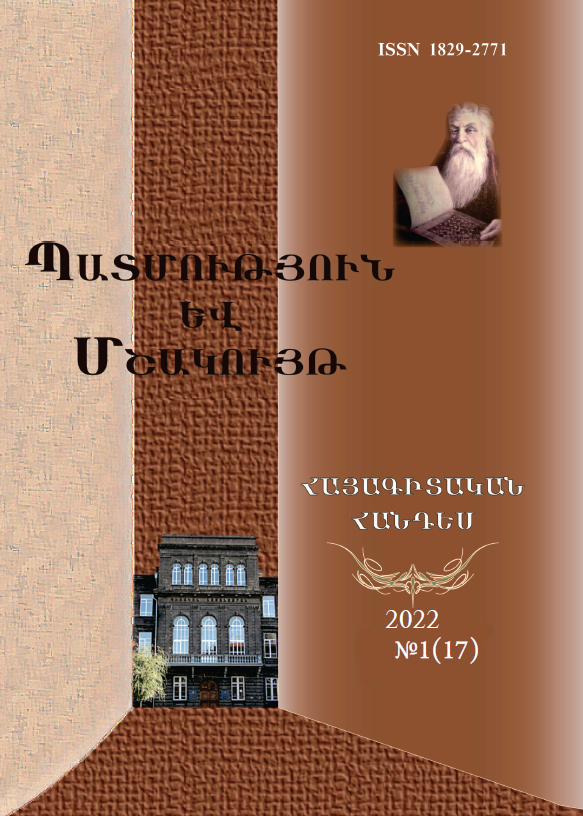The Internal Policy of Armenian King Arshak II
DOI:
https://doi.org/10.46991/hc.2022.17.1.007Keywords:
Arshak II, Catholicos Nerses, Gnel, Tirit, domestic policy, Arshakavan, minister, church, Hayr mardpetAbstract
To summarize, we can state that Arshak II's domestic policy is one of the most educational chapters in the Armenian history. From the very beginning of his reign, the Armenian king pursued the idea of strengthening of the state, and his every action in domestic politics was aimed at it.
Owing to the temporary lull in the region at the start of his reign, Arshak II was able to greatly consolidate his position inside the country (kingdom). First and foremost, the Armenian king began to return the ministers who had left their domains to the court, appoint border guards in all regions of the kingdom, strengthen the army, and effectively finish the battle for the throne.
During the second phase of his reign, the Armenian king was able to maintain a consistent battle against the economically powerful ministers and the church. Firstly, Arshak II established the city of Arshakavan, enabling those displeased with the lords and the church to reside there. Dissatisfied with the king, the ministers attacked the city, destroying it and slaughtering the inhabitants. Then a war erupted amongst the king and the lords, but neither side was victorious. Catholicos Nerses reconciled them at the request of Arshak II and the lords. Not long after the events at Arshakavan, however, Arshak II assaulted the lords, thereby nullifying the agreement. The Kamsarakans were among the first to be punished. To restore the country's internal unity, Arshak II dismissed Nerses from the position of Catholicos and nominated one of his faithful clergymen, Chunak, as the new Catholicos.
References
ԳՐԱԿԱՆՈՒԹՅԱՆ ՑԱՆԿ
Աստուրեան Հ. (1912), Քաղաքական վերաբերութիւններ ընդմէջ Հայաստանի եւ Հռովմայ 190 էն ն. Ք. մինչեւ 428 յ. Ք., Վենետիկ, հրատ. Ս. Ղազար, 391 էջ:
Արմեն Հ. (1967), Արշակունիք և լուսավորչյաններ, «Պատմաբանասիրական հանդես», N 1, 54-64 էջ:
Գարագաշեան Ա. (1895), Քննական պատմութիւն հայոց, ըստ նորագոյն պատմական, լեզուաբանական եւ բանասիրական տեղեկութեանց, մասն Գ, Թիֆլիս, հրատ. Մ. Դ. Ռօտինեանցի, 381 էջ:
Լեո (1966), Երկերի ժողովածու, հ. Ա, Ե., հրատ. «Հայաստան», 567 էջ:
Կանոնագիրք հայոց (1964), հ. Ա, աշխատասիրությամբ Վ. Հակոբյանի, Ե., հրատ. ՀՍՍՌ ԳԱ, 740 էջ:
Հայոց պատմություն (2018), ԳԱԱ, հ. Բ, Միջին դարեր (IV դ.-XVII դ. առաջին կես), գք. Ա (IV դ. սկիզբ - IX դ. կես), Ե., հրատ. «Զանգակ-97», 704 էջ:
Հարությունյան Հ. (1945), Հայաստանը Արշակունիների ժամանակ (1-429 թթ.), Ե., հրատ. Մանկավարժական ինստիտուտի, 155 էջ:
Մանանդյան Հ. (1934), Ֆեոդալիզմը հին Հայաստանում (Արշակունիների ու մարզպանության շրջան), Ե., հրատ. Մելքոնյան ֆոնդի, 337 էջ:
Մանանդյան Հ. (1978), Քննական տեսություն հայ ժողովրդի պատմության, հ․ Բ, մաս Ա, Ե., ՀՍԱՀ ԳԱ հրատ., 646 էջ:
Մովսես Խորենացի (1981), Պատմութիւն հայոց, բնագիրը և ներածութիւնը Մ. Աբեղեանի և Ս. Յարութիւնեանի, Ե., «Երևանի համալս.», 588 էջ:
Մովսիսեան Յ. (1884), Հայաստանեայցս առաքելական Ս. Եկեղեցւոյ պատմութիւն, Վաղարշապատ, հրատ. Սրբոյ կաթողիկէ Էջմիածնի, 381 էջ:
Մուրատեան Ե. (1900), Քննական պատմութիւն Արշակ Երկրորդի եւ անոր Պապ որդւոյն, Աղեքսանդրիա, հրատ. «Արաքս», 198 էջ:
Պալասանեան Ս. (1902), Պատմութիւն հայոց, սկզբից մինչեւ մեր օրերը, Թիֆլիս, հրատ. Տ. Մ. Ռօտինեանցի, 571 էջ:
Պետրոսյան Ե. (1995), Հայ եկեղեցու պատմություն, մասն Ա (սկզբից մինչև 1441 թ.), Էջմիածին, հրատ. Մայր աթոռ Ս. Էջմիածին, 188 էջ:
Փավստոս Բուզանդ (1987), Պատմութիւն հայոց, բնագիրը Ք. Պատկանեանի, Ե., «Երևանի համալս.», 456 էջ:
Օրմանեան Մ․ (1909), Տրդատէ Արտաշէս ժամանակագրական դիտողութիւններ, «Հանդես ամսօրեայ», թիւ 8, օգոստոս, 241-246 էջ:
Аммиан Марцеллин (2005), Римская История, перевод с латинского Ю. Кулаковского и А. Сонни, Москва, Издательство «АСТ», 631 с.
Markwart J. (1930), Südarmenien und die Tigrisquellen nach griechischen und arabischen Geographen, Studien zur armenischen Geschichte, IV, Wien, ''Mechitharisten-Buchdruckerei'', 125-628 s.
Markwart J. (1932), Die Entstehung der armenischen Bistümer: kritische Untersuchung der armenischen Überlieferung, Orientalia Christiana, Vol. XXVII, Septembri, Num. 80, Roma, 137-236 s.
REFERENCES
Asdurjean H. (1912), K‘aghak‘agan vjerajerut‘iwnnjer ěntmēj Hayasdani yw Hrovmay 190 ēn n. K‘. minch‘yw 428 y. K‘., Vjenjedig, hrad. S. Ghazar, 391 ēj:
Armjen H. (1967), Arshakunik‘ ew lusavorch‘yannjer, «Patmabanasirakan handjes», N 1, 54-64 ēj:
Karakashjean A. (1895), K‘nnagan badmut‘iwn hayots‘, ěsd norakoyn badmagan, ljezuapanagan yw panasiragan djeghjegut‘jeants‘, masn G, T‘i flis, hrad. M. T. Rōdinjeants‘i, 381 ēj:
Ljeo (1966), JErkjeri zh’oghovatsu, h. A, JE., hrat. «Hayastan», 567 ēj:
Kanonagirk‘ hayots‘ (1964), h. A, ashkhatasirut‘yamp V. Hakobyani, JE., hrat. HSSR GA, 740 ēj:
Hayots‘ patmut‘yun (2018), GAA, h. B, Mijin darjer (IV d.-XVII d. arajin kjes), gk‘. A (IV d. skizb - IX d. kjes), JE., hrat. «Zangak-97», 704 ēj:
Harut‘yunyan H. (1945), Hayastaně Arshakuninjeri zh’amanak (1-429 t‘t‘.), JE., hrat. Mankavarzh’akan instituti, 155 ēj:
Manandyan H. (1934), Fjeodalizmě hin Hayastanum (Arshakuninjeri u marzpanut‘yan shrjan), JE., hrat. Mjelk‘onyan fondi, 337 ēj:
Manandyan H. (1978), K‘nnakan tjesut‘yun hay zh’oghovrdi patmut‘yan, h․ B, mas A, JE., HSAH GA hrat., 646 ēj:
Movsjes Khorjenats‘i (1981), Patmut‘iwn hayots‘, pnakirě ew njeratsut‘iwně M. Abjeghjeani ew S. Harut‘iwnjeani, JE., «JErewani hamals.», 588 ēj:
Movsisjean H. (1884), Hayastanjeayts‘s arak‘jelagan S. JEgjeghjets‘woy batmut‘iwn, Vagharshabat, hrat. Srpoy kat‘oghigē Ējmiadzni, 381 ēj:
Muradjean JE. (1900), K‘nnagan badmut‘iwn Arshag JErgrorti yw anor Bab ordwoyn, Aghjek‘santria, hrad. «Arak‘s», 198 ēj:
Balasanjean S. (1902), Batmut‘iwn hayots‘, sgzpits‘ minch‘yw mjer ōrjerě, T‘i flis, hrat. T. M. Rōtinjeants‘i, 571 ēj:
Pjedrosyan JE. (1995), Hay jekjeghjets‘u patmut‘yun, masn A (skzbits‘ minch‘ew 1441 t‘.), JEjmiatsin, hrad. Mayr at‘or S. JEjmiatsin, 188 ēj:
P‘avstos Buzand (1987), Patmut‘iwn hayots‘, bnagirě K‘. Patkanjeani, JE., «JErewani hamals.», 456 ēj:
Ōrmanjean M․ (1909), Drtadē Ardashēs zh’amanagakragan tidoghut‘iwnnjer, «Hantjes amsōrjeay», t‘iw 8, ōgosdos, 241-246 ēj:
Ammian Maрcjellin (2005), Рimсkaja Iсtoрija, pjeрjevod с latinсkogo Ju. Kulakovсkogo i A. Сonni, Moсkva, Izdatjel’сtvo «AСT», 631 с.
Markwart J. (1930), Südarmenien und die Tigrisquellen nach griechischen und arabischen Geographen, Studien zur armenischen Geschichte, IV, Wien, ''Mechitharisten-Buchdruckerei'', 125-628 s.
Markwart J. (1932), Die Entstehung der armenischen Bistümer: kritische Untersuchung der armenischen Überlieferung, Orientalia Christiana, Vol. XXVII, Septembri, Num. 80, Roma, 137-236 s.
Downloads
Published
Issue
Section
License
Copyright (c) 2022 Edgar Varshamyan

This work is licensed under a Creative Commons Attribution-NonCommercial-ShareAlike 4.0 International License.

